I’ve spent the last two weeks looking into moss conservation around the world– how are mosses faring? have we taken conservation action? do we need to? And I feel like the most common response I found in literature dated as recently as nine years ago was ‘We don’t have enough information to judge.’ This is definitely a concern- if mosses are struggling, we need to know this so we can take steps to support populations. If mosses are fine, let’s take our limited conservation resources and focus on organisms that are in trouble. If we don’t know what is going on, that puts us in a difficult position.

Mosses can be some of the first plants to colonize bare substrate, like these lava beds- they provide important habitats for other organisms to colonize, but they can be very sensitive to changes in habitat.
How blurry is the situation? While there are definite gaps in our knowledge, I think several general trends are emerging which suggest some mosses could use our help. Researchers working on a number of continents have recognized that mosses are impacted by both global and local habitat changes. At the global scale, increasing levels of air and water pollution impact mosses more than some of the other plants we are familiar with (Söderström et al. 1992, Cleavitt 2005). Part of this has to do with moss anatomy- as non-vascular plants they absorb a lot of things from their environment directly through leaves and stems with less of a filter for harmful substances. Part of this has to do with habitat- mosses are typically found in wetter habitats and that means that they may sit in acid rain or polluted run-off after a storm.
At the local level, mosses are very sensitive to changes in microclimate, for example humidity (Lõhmus et al. 2006) or light (Rothero 2003). Researchers in Sweden found that mosses near newly-logged areas were less-impacted by a thinned forest if they were growing in concave depressions on the ground than if they were growing on mounds and had less access to groundwater (Hylander et al. 2005). Mosses in the boreal forest were more numerous and diverse on hardwood than softwood debris, probably because of the higher acidity of softwoods like pines (Mills and Macdonald 2004). Since logging in general creates changes in microhabitat through less plant cover, greater wind and light exposure, and soil disturbance, we should expect that logging can be a big challenge for moss populations. And a lot of forest management in colder climates involves pines and other softwoods, so mosses may be losing habitat in that respect, too.
If we combine those issues with moss harvest, we are impacting mosses both directly and indirectly. Researchers in West Virginia reported that moss harvesters were collecting more rock-based mosses because log-growing mosses were less common in managed forests (Studlar and Peck 2007)- a change in collection could impact community structure. And a switch in moss harvesting in the Pacific Northwest from harvesting scattered patches to stripping whole sections of forest slowed moss regrowth by taking all adjacent mats together and reduced populations of late-successional species because harvest was so often (Peck and Frelich 2008).
So we do know mosses are facing challenges even if we don’t know all of the details. For my next post I’ll look at more recent research and options for mitigating negative impacts on moss communities.
Works cited:
Cleavitt, N.L. 2005. Patterns, Hypotheses and Processes in the Biology of Rare Bryophytes. The Bryologist 108:554–566.
Hylander, K., M. Dynesius, B.G. Jonsson, and C. Nilsson. 2005. Substrate Form Determines the Fate of Bryophytes in Riparian Buffer Strips. Ecological Applications 15:674–688.
Lõhmus, P., R. Rosenvald, and A. Lõhmus. 2006. Effectiveness of solitary retention trees for conserving epiphytes: differential short-term responses of bryophytes and lichens. Canadian Journal of Forest Research 36:1319–1330.
Mills, S.E., and S.E. Macdonald. 2004. Predictors of Moss and Liverwort Species Diversity of Microsites in Conifer-Dominated Boreal Forest. Journal of Vegetation Science 15:189–198.
Peck, J.E., and L.E. Frelich. 2008. Moss Harvest Truncates the Successional Development of Epiphytic Bryophytes in the Pacific Northwest. Ecological Applications 18:146–158.
Rothero, G. 2003. Bryophyte conservation in Scotland. Botanical Journal of Scotland 55:17–26.
Söderström, L., T. Hallingbäck, L. Gustaffson, N. Cronberg, and L. Hedenäs. 1992. Bryophyte conservation for the future. Biological Conservation 59:265–270.
Studlar, S.M., and J.E. Peck. 2007. Commercial Moss Harvest in the Appalachian Mountains of West Virginia: Targeted Species and Incidental Take. The Bryologist 110:752–765.

These mosses seem to be quite happy living on rock in moisture-rich Iceland.
I recently read a book telling the fictional story of a woman from the 1800s who studied mosses, and it occurred to me that I have really no clue about moss conservation or even moss ecology. I know that mosses tend to grow in moist locations, they don’t get very tall, and, like all plants, their generations alternate between spore-producing and gamete-producing forms. That’s not a lot to go on. Since I often see mosses growing between cracks in the pavement or on the bark of trees, it may be that their place in our world is relatively secure. It may be that they face big challenges. And perhaps we just don’t know enough to pick a side. So I’ll be spending the next few weeks trying to get a sense of how stable moss populations are around the world, whether they face any conservation challenges, and if they play a role in the conservation issues of other organisms.
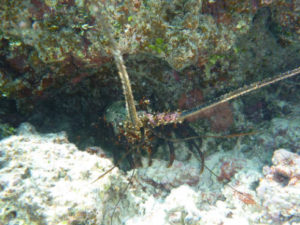
And remember that conservation of coral reefs means support for all of the species that live there, even if they aren’t fish! Photo courtesy of USFWS
Over the last few weeks, I’ve described some of the big challenges facing reef fish and the coral reefs they inhabit- some of those issues are very big, such as the scale of climate change and ocean acidification, and some of those issues occur on a much smaller scale, such as when fishermen use cyanide to stun fish for capture. While we may not be able to turn back the clock on all of these issues, there are things we can each do to help support these fish and their homes.
In your daily life
If you want to support conservation efforts from a distance
If you’d like to get more directly involved, there are lots of options- some of these involve scuba diving, but some organizations will train you-
So there are lots of ways we can all get involved in reef fish conservation- hopefully you can find something that matches your available time and interests- and don’t forget about volunteering with a local aquarium- educating the public is a great way to expand conservation efforts!
In my last post I mentioned some of the challenges facing reefs and reef fish, particularly overexploitation and habitat degradation. Although these issues affect reef fish in different ways, they can work in tandem to intensify conservation problems. The good news is that we have better insight into how to lessen or even remove some of these challenges. The bad news is that, in some cases, the odds are stacked against the fish.

Some species of fish will only settle on reefs with adequate habitat quality. Photo by J Maragos and courtesy of USFWS.
As I said before, fisheries don’t exploit all species equally– some fish species are more prized than others. When fishing selectively removes fish that fill certain roles, we can see a cascading effect throughout the ecosystem. Raymundo et al. (2009) found that coral within protected areas showed less evidence of disease, perhaps because fishing in other areas preferentially removed the predators which controlled smaller coral-eating fish. Another study recommended switching from spear gun- and trap-based fishing to line fishing because lines catch a smaller proportion of the fish that help with coral recovery rather than slowing it (Cinner et al. 2009). Why is it important to limit coral disease and damage? Based on research by Feary et al. (2007), degraded coral habitats can create a self-reinforcing trend in which fish larvae are less likely to settle on degraded coral, so there are fewer fish to maintain ecosystem function, so the reef degrades more, so fewer fish larvae settle…and so on.
Are there things we can do, aside from altering fishery practices to improve reef habitats? Yes, although we are still figuring out our best strategies. According to research in Indonesia, creating stable rock platforms for larval coral to colonize led to greater coral recruitment in areas which had been damaged by blast fishing (Fox et al. 2005). However, it was important to maintain rock stability over the long term, since strong currents could move things around, so working over large areas at a time might be the best course of action. Graham et al. (2013) recommended using extreme weather events, such as massive rain inputs or cyclical cold spells, as catalysts for action so that we take advantage of natural events to start removing invasive fish species or algae that smothers coral. It is important, however, to recognize that the reefs we end up with may not be exact replicas of what they once were. Research on the Great Barrier Reef found that, 13 years after a bleaching event, while the roles that fish species filled were the same as before the bleaching, some of the species themselves had been replaced- rather than being restored, the reef had regenerated in a slightly different form (Bellwood et al. 2012).
And the reality is that climate change will continue to push fish outside of their comfort zone. I mentioned the problem of ocean acidification in my last post- it turns out that there’s a lot more going on there than you might expect. Research on clownfish has found that fish exposed to the acidity levels expected by 2100 had trouble distinguishing good habitat from bad because they couldn’t read the olfactory cues (Munday et al. 2009) and engaged in riskier behavior which led to higher mortality rates (Munday et al. 2010).
So, while we can make some adjustments to support reef fish populations, other factors may be moving beyond our control. What can we, as individuals, do to help these organisms and the ecosystems they inhabit? That’s what I’ll look into for my final post of the month.
Works cited:
Bellwood, D.R., A.H. Baird, M. Depczynski, A. González-Cabello, A.S. Hoey, C.D. Lefèvre, and J.K. Tanner. 2012. Coral recovery may not herald the return of fishes on damaged coral reefs. Oecologia 170:567–573.
Cinner, J.E., T.R. McClanahan, N.A.J. Graham, M.S. Pratchett, S.K. Wilson, and J.-B. Raina. 2009. Gear-Based Fisheries Management as a Potential Adaptive Response to Climate Change and Coral Mortality. Journal of Applied Ecology 46:724–732.
Feary, D.A., G.R. Almany, M.I. McCormick, and G.P. Jones. 2007. Habitat Choice, Recruitment and the Response of Coral Reef Fishes to Coral Degradation. Oecologia 153:727–737.
Fox, H.E., P.J. Mous, J.S. Pet, A.H. Muljadi, and R.L. Caldwell. 2005. Experimental Assessment of Coral Reef Rehabilitation Following Blast Fishing. Conservation Biology 19:98–107.
Graham, N.A., D.R. Bellwood, J.E. Cinner, T.P. Hughes, A.V. Norström, and M. Nyström. 2013. Managing resilience to reverse phase shifts in coral reefs. Frontiers in Ecology and the Environment 11:541–548.
Munday, P.L., D.L. Dixson, J.M. Donelson, G.P. Jones, M.S. Pratchett, G.V. Devitsina, K.B. Døving, and D.M. Karl. 2009. Ocean Acidification Impairs Olfactory Discrimination and Homing Ability of a Marine Fish. Proceedings of the National Academy of Sciences of the United States of America 106:1848–1852.
Munday, P.L., D.L. Dixson, M.I. McCormick, M. Meekan, M.C.O. Ferrari, D.P. Chivers, and D. Karl. 2010. Replenishment of fish populations is threatened by ocean acidification. Proceedings of the National Academy of Sciences of the United States of America 107:12930–12934.
Raymundo, L.J., A.R. Halford, A.P. Maypa, A.M. Kerr, and D.M. Karl. 2009. Functionally Diverse Reef-Fish Communities Ameliorate Coral Disease. Proceedings of the National Academy of Sciences of the United States of America 106:17067–17070.
Over the past week I’ve been looking into the challenges facing reef fishes and the environments they inhabit, and there are some very clear recurrent themes: overexploitation (on a number of levels), habitat degradation (for a variety of reasons), and climate change. These are all big issues and unfortunately some of them are probably not going away any time soon. My goal here is to give you some general background, so that in future posts we can look at possible solutions and mitigation strategies.
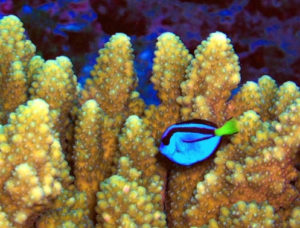
Demand for blue tangs in aquaria was originally satisfied by capturing these fish in the wild, a practice with big repercussions for the wild populations. Photo by J Maragos and courtesy of USFWS.
Overexploitation of reef fish comes from both the food trade and the aquarium trade, so there are several different pressures on fish populations and fishing methods involved. In addition to the use of nets (which can damage coral they get caught on- Öhman et al. 1993), fishermen also use explosives in some areas to kill fish and cyanide is used to stun fish for capture and sale in the aquarium trade (Hinrichsen 1997). Although we might think of the aquarium trade as being as a fairly stable industry in which fish are raised for sale, as of 2001 less than 1 % of marine fish in the aquarium trade were farmed (Wood 2001), so the public demand for colorful reef fish to own can have a big impact on wild stocks. Foster & Vincent (2005) suggested that there be a minimum size limit for seahorses collected from wild stocks to ensure that fish could mature and reproduce (thus contributing to future generations) before going into someone’s aquarium or traditional medicine. And there can be collateral damage to non-target species as well- fishermen catching Banggai cardinalfish in Indonesia use sea urchins to lure the fish into traps, sometimes harming the urchin in the process (Kolm and Berglund 2003). The same study also found that fished areas had smaller groups of cardinalfish (which seem to have a group-homing instinct) and this could make them more vulnerable to predation.
Even when the reef fish populations aren’t being directly exploited, they oftentimes face habitats that are reduced versions of what they once were. In addition to collecting corals for the aquarium trade, some coral reefs are mined for building materials and lime production (Berg et al. 1998). Since corals are accreted slowly over time, coral mining tends to remove coral formations faster than they can develop. Sedimentation of reefs is another issue- as run-off from land (because of land clearing, increased erosion, etc.) deposits mud and other particles on reefs, it can smother the corals (Rajasuriya et al. 1995). Pollution also degrades reef systems [and sometimes it’s a type of pollution we might not be expecting- underwater testing of explosives, such as those carried out on Mururoa Atoll between 1976 and 1995, creates huge changes in water pressure and fish with swim bladders can’t survive the changes if they are too close to the blast zone (Planes et al. 2005)].
Climate change adds another layer of stress to these reef systems, and it comes on two fronts. One of the issues is the rising temperature of the water- the corals that we find in reefs are often working in symbiosis with dinoflagellates which provide most of the energy the corals use, but these relationships can be undone by rising temperatures and this results in coral ‘bleaching’ (Hoegh-Guldberg et al. 2007). In addition to rising temperatures, climate change features an increasingly acidic ocean as more and more carbon dioxide is absorbed- this is a very big problem for corals because they use carbonate to create their hard structures, and carbonate becomes scarce in acidic waters. As a result, we could see no or even negative coral growth once the oceans hit a certain level of acidity.
So there are some very big challenges facing reef fishes and the coral reefs they inhabit- some of this is directly related to our oceanic activities and some of it comes from larger issues of climate change. Plus we have the decisions people make about what to have in their aquaria. Do we have options for helping coral meet some of these challenges? That’s what I’ll search for in my next post.
Works cited:
Berg, H., M.C. Öhman, S. Troëng, and O. Lindén. 1998. Environmental Economics of Coral Reef Destruction in Sri Lanka. Ambio 27:627–634.
Foster, S.J., and A.C.J. Vincent. 2005. Enhancing Sustainability of the International Trade in Seahorses with a Single Minimum Size Limit. Conservation Biology 19:1044–1050.
Hinrichsen, D. 1997. Coral Reefs in Crisis. BioScience 47:554–558.
Hoegh-Guldberg, O., P.J. Mumby, A.J. Hooten, R.S. Steneck, P. Greenfield, E. Gomez, C.D. Harvell, P.F. Sale, A.J. Edwards, K. Caldeira, N. Knowlton, C.M. Eakin, R. Iglesias-Prieto, N. Muthiga, R.H. Bradbury, A. Dubi, and M.E. Hatziolos. 2007. Coral Reefs under Rapid Climate Change and Ocean Acidification. Science 318:1737–1742.
Kolm, N., and A. Berglund. 2003. Wild Populations of a Reef Fish Suffer from the “Nondestructive” Aquarium Trade Fishery. Conservation Biology 17:910–914.
Öhman, M.C., A. Rajasuriya, and O. Lindén. 1993. Human Disturbances on Coral Reefs in Sri Lanka: A Case Study. Ambio 22:474–480.
Planes, S., R. Galzin, J.-P. Bablet, and P.F. Sale. 2005. Stability of Coral Reef Fish Assemblages Impacted by Nuclear Tests. Ecology 86:2578–2585.
Rajasuriya, A., M.W.R.N.D. Silva, and M.C. Öhman. 1995. Coral Reefs of Sri Lanka: Human Disturbance and Management Issues. Ambio 24:428–437.
Wood, E. 2001. Collection of coral reef fish for aquaria: global trade, conservation issues and management strategies. Marine Conservation Society, UK. Available online at http://agris.fao.org/agris-search/search.do?recordID=GB2013200400. Accessed September 8, 2016.
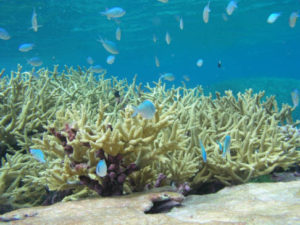
Not sure if what kinds of issues these Chromis face, but they are wonderful to watch in action! Photo by A Meyer and courtesy of USFWS
During a recent trip to New England, I spent an afternoon wandering around an aquarium- I love watching all of the undersea life, but one of my favorite exhibits is always the shallow coral reefs with their diversity of brightly-colored fish. I know that there are a number of conservation concerns for the fish we see in salt and fresh water tanks, both in large public aquaria and in the tanks we have in our homes. Some of those concerns have to do with the aquarium trade itself, but other concerns stretch to the wild populations which are facing issues like climate change and pollution.
But I don’t know many of the details about those conservation issues, especially when it comes to the aquarium trade, so this month I’m going to look into the conservation status of fish found on coral reefs, as well as best practices for having some of those same fish in an aquarium. This is likely to be a very, very big topic- I mean, the world’s oceans have a wide variety of reef systems and fish within those systems- so I may focus in on specific aspects, but hopefully I can also provide a sense of larger trends, too.
So, if you enjoy watching those colorful fish dart in and out of coral formations as much as I do, hopefully this month I can provide a picture of the larger conservation issues they face.

Boreal chickadees are boreal residents that benefit from forest conservation. Photo by Nina Hale- license link
As you’ve seen in my previous posts, there are some big issues facing boreal forests and the birds that live there both as summer migrants and year-round. These issues include habitat loss and fragmentation, as well as the impacts of climate change. Some researchers have suggested that we need to protect large areas of important habitat and also create paths between them so that the birds (and other animals) can move as conditions change. Conservation at this scale can be a challenge, so it’s important for all of us to get involved.
Options to get involved with conservation at a big, big scale:
And if you’re looking for something close to home:
We all have many opportunities, both big and small, to help out boreal birds!
In my last post, I talked about the impacts of forest loss and fragmentation on boreal birds. These issues impact birds whether they are year-round residents or summer visitors, and the impacts can be pretty intense- Sauer et al. (2005) estimated that the boreal chickadee population experienced an annual decline of about 3.6% between 1966 and 2004 in eastern North America. Unfortunately, boreal birds face more than deforestation due to logging or land development.

Greater Scaup breed in boreal habitats, but spend the winter elsewhere- thus far, they don’t seem to be adjusting the timing of migration to earlier springs. Photo by D Dewhurst and courtesy of USFWS.
The world’s boreal forests lie at the latitudes expected to experience the greatest temperature increases as the climate warms, and that means they will also experience changing fire- and water-regimes, changing plant ranges and growth rates, and changing yearly calendars (Ruckstuhl et al. 2008). That’s a lot of change, and we are still figuring out exactly what it all means for the plants and animals that live there. Rather than be overwhelmed by the sheer scale of change expected, let’s talk about changes in timing (or phenology) and how that interacts with changes in range. It should come as no surprise that warmer global temperatures can translate into earlier springs, and not just in boreal landscapes- I grew up in rural New Hampshire and saw that lilacs (my favorite flowers) bloomed in late May/early June when I was little, but now bloom in early May. You might think that earlier springs help birds out by expanding the period when plants, insects, and other food sources are more plentiful, but some birds initiate migration to breeding grounds not on the basis of weather conditions, but on day-length. Research into scooter and scaup populations in western North America suggests that earlier springs mean the birds may miss the peak abundance of their main food sources because they aren’t migrating earlier for breeding (Drever et al. 2012). Other birds are able to respond to changing temperatures, but that may not fix everything over the long-term. Willow tits in Finland, for example, are breeding earlier each year, and luckily the caterpillar which is their main food during nesting is also hatching earlier (Vatka et al. 2011). The rate of change for the two species is different, however- for the moment, that means that the period when the birds need the most food is a better match with peak caterpillar abundance. But the time will come when the two species start drifting apart, and that will make it more difficult for the birds to successfully raise young.
And the mismatch is not just about whether or not the right insects are available at the right time during a summer season- we’re also talking about whether habitat can shift as quickly as bird ranges can. Researchers in Sweden found that the limit of certain tree species had shifted upward in altitude by 70-90 m in the 20th century (Kullman and Öberg 2009). While that suggests that plants can respond to climate change, think about the timescale here and how mobile birds are- birds can disperse faster than plants can, so there are concerns that suitable temperatures and weather patterns for birds will shift more quickly than the plants which provide food and shelter (Stralberg et al. 2015).
So, boreal birds are facing a number of big challenges- do we have options for mitigating some of these effects? Yes, but it requires some changes in management and some planning at a large scale. To lessen habitat loss, researchers have suggested that we limit thinning in managed forests to both encourage the development of a shrub layer (and the fruits eaten by birds before migration) (Major and Desrochers 2012) and maintain snags for nesting (Vatka et al. 2014). Cardinal et al. (2012) also suggested limiting deer populations just after timber harvest to enable the forest to regenerate more effectively (and there is a whole body of literature on how moose and deer browsing impacts birds, if you’re interested in that relationship).
One of the most important things we can do right now is to protect large areas of different habitats (Stralberg et al. 2015), especially mature forest because it takes so long to develop, and then provide birds with intermediate patches of habitat to facilitate movement between locations (Glennon 2014)- admittedly, that’s a tall order and, as you’ll see in my next post, that’s exactly where all of us come into play.
Works cited:
Cardinal, E., J.-L. Martin, J.-P. Tremblay, and S.D. Cote. 2012. An experimental study of how variation in deer density affects vegetation and songbird assemblages of recently harvested boreal forests. Canadian Journal of Zoology 90:704–713.
Drever, M.C., R.G. Clark, C. Derksen, S.M. Slattery, P. Toose, and T.D. Nudds. 2012. Population vulnerability to climate change linked to timing of breeding in boreal ducks. Global Change Biology 18:480–492.
Glennon, M.J. 2014. Dynamics of Boreal Birds at the Edge of their Range in the Adirondack Park, NY. Northeastern Naturalist 21:NENHC-51.
Kullman, L., and L. Öberg. 2009. Post-Little Ice Age tree line rise and climate warming in the Swedish Scandes: a landscape ecological perspective. Journal of Ecology 97:415–429.
Major, M., and A. Desrochers. 2012. Avian use of early-successional boreal forests in the postbreeding period – Utilisation des jeunes peuplements d’une forêt boréale par les oiseaux après la période de nidification. The Auk 129:419–426.
Ruckstuhl, K.E., E.A. Johnson, and K. Miyanishi. 2008. Introduction. The boreal forest and global change. Philosophical Transactions of the Royal Society B: Biological Sciences 363:2243–2247.
Sauer, J.R., J.E. Hines, and J. Fallon. 2005. The North American breeding bird survey, results and analysis 1966-2004. USGS, Patuxent Wildlife Research Center, Laurel, Maryland, USA.
Stralberg, D., E.M. Bayne, S.G. Cumming, P. Sólymos, S.J. Song, and F.K.A. Schmiegelow. 2015. Conservation of future boreal forest bird communities considering lags in vegetation response to climate change: a modified refugia approach. Diversity and Distributions 21:1112–1128.
Vatka, E., K. Kangas, M. Orell, S. Lampila, A. Nikula, and V. Nivala. 2014. Nest site selection of a primary hole-nesting passerine reveals means to developing sustainable forestry. Journal of Avian Biology 45:187–196.
Vatka, E., M. Orell, and S. Rytkönen. 2011. Warming climate advances breeding and improves synchrony of food demand and food availability in a boreal passerine. Global Change Biology 17:3002–3009.
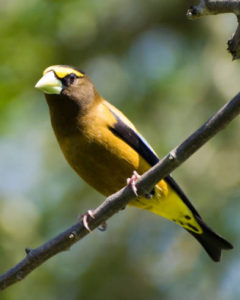
The evening grosbeak is one boreal species that has seen dramatic population declines. Photo by G Gentry and courtesy of USFWS
When we think of boreal forests, we may think of dense networks of coniferous trees covering the landscape, but the reality is a bit more complicated than that- in addition to deciduous trees in the understory and canopy and bodies of water of all shapes and sizes, boreal forests are mosaics with patches of different ages, structures, and species compositions (Hansson 1992). Wildfires, storms, insect outbreaks and a number of other disturbances constantly change the look of the forest killing plants, opening up areas for new colonization, and creating complex habitat for wildlife. So if trees are constantly dying and vegetation patches continually disappear from the forest, the animals that live there should be pretty well set to deal with many kinds of change, right? The disturbances caused by people fit well within their tolerances? The answer to that question is slightly yes, but largely no- when humans come into the forest, things start to change in new ways, some of which boreal birds can adjust to, but others of which create real problems for these species. Why is this important? Well, birds represent more than 75% of all vertebrate species in boreal forests (Monkkonen and Viro 1997) and in eastern Canada alone more than 70 songbird species are commonly found nesting in boreal habitat (Erskine 1977).
For the most part, logging does not mimic the natural processes that keep boreal forests in flux. Sometimes forest management involves removing everything from blocks of forest- but clear-cutting creates sharp edges between open and forested land, whereas storm damage and insects rarely work in well-defined polygons. And while wildfires and logging both remove understory and kill trees, logging tends to be much more selective in what is removed and what stays. Wildfires leave some dead trees from a variety of species standing, but logging practices may remove all dead snags, depriving cavity nesting birds of the trees they need. At the same time, the management rotation may remove the deciduous understory when thinning coniferous stands, which removes important habitat for other forest birds (Thompson et al. 1999), or harvest may be too frequent for certain tree species to mature (Hobson and Bayne 2000). What do these differences mean for boreal birds? Studies in North America and Europe suggest that bird species are lost as old-growth forest is converted into logged stands- work in both Fennoscandia (Imbeau et al. 2001) and western Canada (Schmiegelow et al. 1997) found that species which don’t migrate, but remain in the forest year-round, were particularly sensitive to the effects of logging. In addition to losing nesting spots, fragmentation of the forest is an issue- Schmiegelow et al.’s (1997) research suggested that even a few hundred meters of open land could be too much for some forest-dwelling species to cross. And recovery after logging is slow- researchers in Alberta found that logged stands had bird communities that still differed significantly from the birds in wildfire-exposed locations 28 years after the disturbances (Hobson and Schieck 1999).
And the disturbances caused by people go beyond logging or road-building or other things we can see in the landscape- we’ve changed what they hear, too. Researchers looking at the compressor stations along oil and gas pipelines running through boreal forest found that the density of passerine birds was considerably lower near the compressors when compared with oil and gas well pads (which don’t have the continuous noise) (Bayne et al. 2008). Since songbirds communicate so often using sound (I mean, they’re called ‘songbirds’), the constant noise seems to lower the quality of the surrounding habitat in the eyes (or ears) of the birds. In fact, male ovenbirds in Alberta had lower success in finding a mate when they resided near compressors (Habib et al. 2007)- perhaps the females couldn’t hear the singing males or their songs sounded funny because of the noise or maybe it’s harder to detect approaching predators so females don’t want to nest there, whatever the case, the males were less likely to pair with a female.
So it seems like we are directly changing the boreal forests, and not really to the general benefit of the avian inhabitants, because of extractive industries. Are we impacting these habitats in other ways, too? And how does climate change fit into this? For my next post, I’ll look into these questions, as well as trying to dig up research on how to counter the problems these birds face.
Works cited:
Bayne, E.M., L. Habib, and S. Boutin. 2008. Impacts of Chronic Anthropogenic Noise from Energy-Sector Activity on Abundance of Songbirds in the Boreal Forest. Conservation Biology 22:1186–1193.
Erskine, A.J. 1977. Birds in boreal Canada: communities, densities and adaptations. Canadian Wildlife Service Report 41.
Habib, L., E.M. Bayne, and S. Boutin. 2007. Chronic industrial noise affects pairing success and age structure of ovenbirds Seiurus aurocapilla. Journal of Applied Ecology 44:176–184.
Hansson, L. 1992. Landscape ecology of boreal forests. Trends in Ecology & Evolution 7:299–302.
Hobson, K.A., and E. Bayne. 2000. Breeding Bird Communities in Boreal Forest of Western Canada: Consequences of “Unmixing” the Mixedwoods. The Condor 102:759–769.
Hobson, K.A., and J. Schieck. 1999. Changes in Bird Communities in Boreal Mixedwood Forest: Harvest and Wildfire Effects over 30 Years. Ecological Applications 9:849–863.
Imbeau, L., M. Mönkkönen, and A. Desrochers. 2001. Long-Term Effects of Forestry on Birds of the Eastern Canadian Boreal Forests: a Comparison with Fennoscandia. Conservation Biology 15:1151–1162.
Monkkonen, M., and P. Viro. 1997. Taxonomic Diversity of the Terrestrial Bird and Mammal Fauna in Temperate and Boreal Biomes of the Northern Hemisphere. Journal of Biogeography 24:603–612.
Schmiegelow, F.K.A., C.S. Machtans, and S.J. Hannon. 1997. Are Boreal Birds Resilient to Forest Fragmentation? An Experimental Study of Short-Term Community Responses. Ecology 78:1914–1932.
Thompson, I.D., H.A. Hogan, and W.A. Montevecchi. 1999. Avian Communities of Mature Balsam Fir Forests in Newfoundland: Age-Dependence and Implications for Timber Harvesting. The Condor 101:311–323.
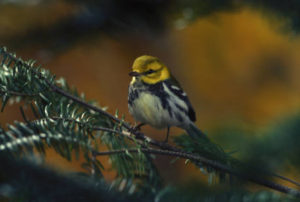
Female black-throated green warbler, just one of the species nesting in boreal forests. Photo by S. Maslowski and courtesy of USFWS.
In July I had the opportunity to attend the North American Congress on Conservation Biology in Madison, Wisconsin. In addition to having a blast in the cooler weather and meeting researchers doing amazing work, I also was reminded that the boreal forests of the world are huge- in fact, they are much, much bigger than I usually think of them as being. And it turns out that they play host to many species from my favorite group of birds, the wood warblers.
But these forests are also on the front lines of conservation due to land conversion and climate change. It would make sense, therefore, that the birds that live in this habitat are also facing big challenges. And since many of those birds migrate on a yearly basis, even if we don’t live in a boreal landscape, many of us still encounter the birds that depend on that habitat.
While I was at the congress, I learned about a group working in Canada to protect huge areas of boreal forest in a bid to give these ecosystems the space they need over the long-term, but Canada is not the only place with these forests. What’s happening in other locations, like Alaska or Russia? How big do we need to be thinking in terms of protection? How are the birds doing right now and what do we expect for the future? I don’t have answers to any of those questions, so, this month, I’m looking at birds in boreal forests- I may live in a completely different environment, but I love seeing those warblers when they migrate through Louisiana, and I’d like to keep seeing them in the future.










